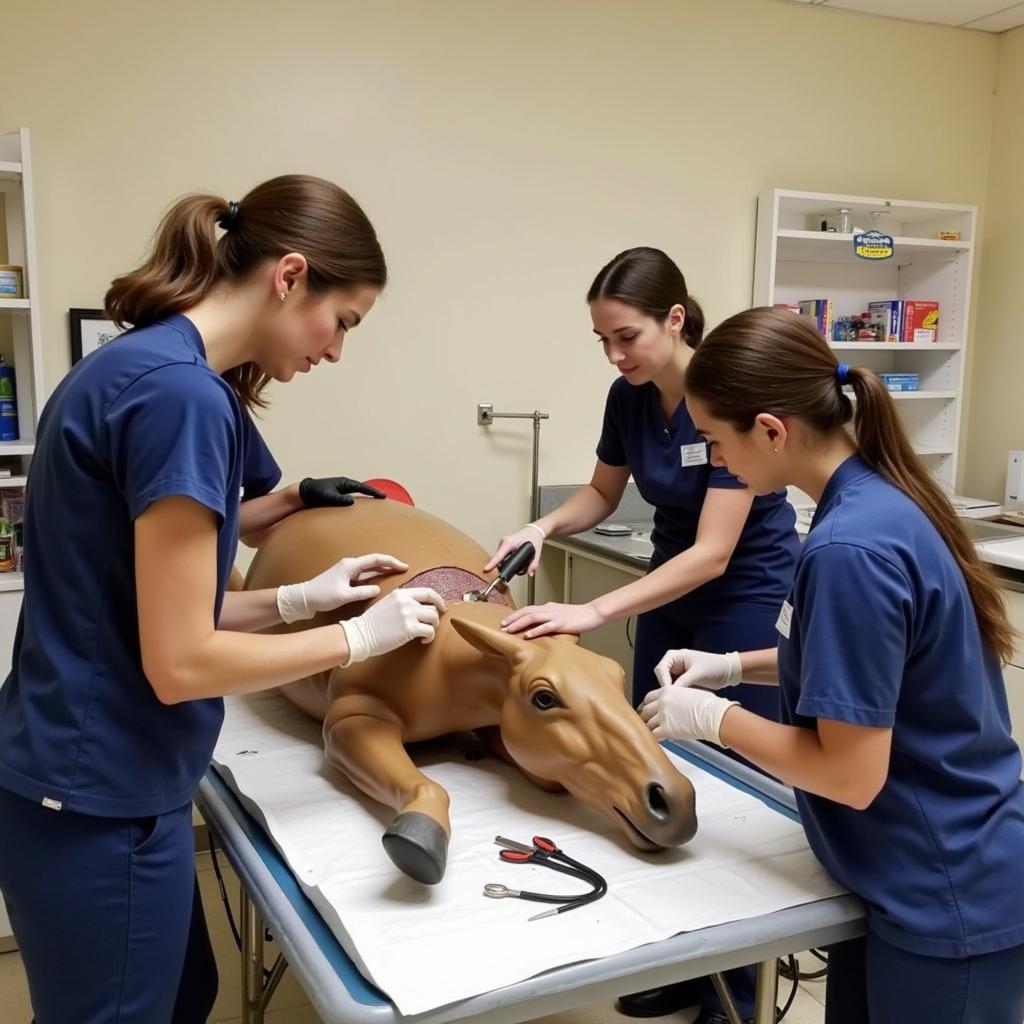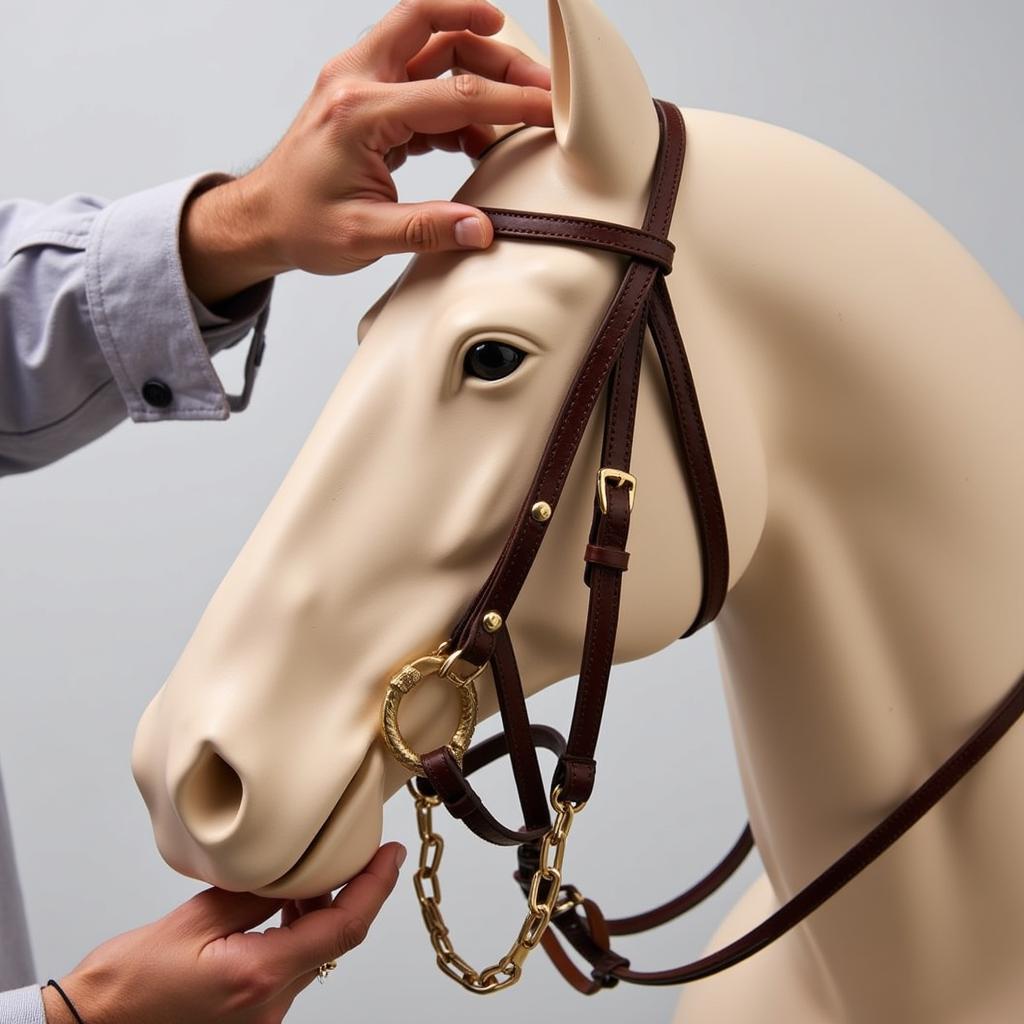Horse Mannequins have become an increasingly popular tool in the equine world, offering a variety of practical applications for riders, trainers, and businesses alike. From fitting saddles and bridles to practicing veterinary procedures and showcasing equestrian apparel, these life-sized equine replicas provide a versatile and humane alternative to using live horses. Let’s explore the numerous benefits and diverse uses of horse mannequins.
What is a Horse Mannequin and Why Use One?
Horse mannequins are essentially life-size replicas of horses, crafted from various materials such as fiberglass, plastic, or even wood. Their purpose is to provide a realistic yet static stand-in for a live horse in situations where using a real animal would be impractical, inconvenient, or potentially stressful for the animal.
Why use a horse mannequin? They offer a safe and consistent platform for a myriad of equine-related activities, eliminating the variables that come with a living, breathing horse. Imagine the convenience of fitting a long horse riding coat on a patient, unmoving model! This allows for precise adjustments and ensures a perfect fit every time.
 Horse mannequin used for veterinary training
Horse mannequin used for veterinary training
Different Types of Horse Mannequins
Horse mannequins are available in various forms, each designed for specific purposes:
- Full-body mannequins: These are the most common type, mimicking the entire horse from head to hoof. They are ideal for saddle fitting, displaying equestrian apparel, and even artistic endeavors.
- Partial mannequins: These may represent just the torso or hindquarters, often used for specialized tasks like saddle making or veterinary practice.
- Head-only mannequins: These are useful for practicing bridle fitting and other head-related procedures.
Benefits of Using a Horse Mannequin for Saddle Fitting
Saddle fitting is crucial for both horse and rider comfort and performance. A poorly fitting saddle can cause pain, discomfort, and even long-term back problems for the horse. Horse mannequins provide a stable platform for assessing saddle fit without the added complication of a moving horse.
- Consistent Shape: Unlike live horses who can shift their weight and posture, a horse mannequin remains perfectly still, allowing for accurate and repeatable measurements.
- Stress-Free Environment: Fitting a saddle on a live horse can be stressful for both the horse and the fitter. A mannequin eliminates this stress, allowing for a more thorough and focused fitting process.
Horse Mannequins in Education and Training
Horse mannequins are increasingly used in educational and training settings:
- Veterinary Schools: Students can practice procedures on a mannequin without risking harm to a live animal.
- Farrier Training: Mannequins provide a consistent hoof shape for practicing trimming and shoeing techniques.
- Riding Instruction: Some instructors use mannequins to demonstrate proper riding posture and positioning. This can be especially helpful for beginners.
 Horse mannequin head for bridle fitting
Horse mannequin head for bridle fitting
Choosing the Right Horse Mannequin
Selecting the right horse mannequin depends on its intended use. Consider the following factors:
- Material: Fiberglass mannequins are durable and weather-resistant, while plastic models are generally more affordable.
- Size and Shape: Choose a mannequin that closely resembles the size and build of the horse you intend to use it for.
- Features: Some mannequins offer adjustable features, such as movable legs or removable parts. For enthusiasts interested in owning a life-sized horse replica, exploring options like life size horses can be incredibly fulfilling.
“A well-chosen horse mannequin can be an invaluable asset for any equestrian professional or enthusiast,” says Dr. Emily Carter, DVM. “Its versatility and practicality make it a worthwhile investment.”
Conclusion: The Horse Mannequin – A Modern Equestrian Essential
From fitting saddles and bridles to training future veterinarians, the horse mannequin has proven to be a versatile and valuable tool in the equine world. Its ability to provide a realistic and humane alternative to using live horses makes it an essential piece of equipment for a wide range of equestrian applications. By choosing the right horse mannequin, riders, trainers, and businesses can enhance their practices and prioritize the well-being of their equine companions.
“Investing in a horse mannequin has significantly improved the efficiency and accuracy of our saddle fitting process,” adds Master Saddler, John Davies. “It’s a game-changer.”
FAQ
- What are horse mannequins made of? They are commonly made of fiberglass, plastic, or wood.
- Are horse mannequins expensive? The price varies depending on the material, size, and features.
- Can I use a horse mannequin outdoors? Fiberglass models are generally weather-resistant and suitable for outdoor use.
- Where can I buy a horse mannequin? They are available from various equestrian retailers and online marketplaces.
- What are the main benefits of using a horse mannequin? They provide a safe, consistent, and stress-free environment for various equine-related tasks.
- Can a horse mannequin replace a live horse for all training purposes? While incredibly useful, they cannot fully replicate the dynamic interaction with a live horse.
- Are there different sizes of horse mannequins available? Yes, they come in various sizes to accommodate different breeds and disciplines.
Need assistance? Contact us at Phone Number: 0772127271, Email: [email protected] or visit us at QGM2+WX2, Vị Trung, Vị Thuỷ, Hậu Giang, Việt Nam. We have a 24/7 customer service team.